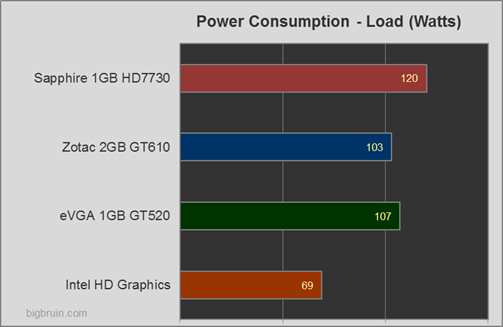Testing (continued):
Power Consumption:
Power consumption testing involved the use of a Seasonic Power Angel to monitor the AC Wattage drawn by the test system. Since all other hardware remained the same from test to test, any change in the power reading can be attributed to the demand of the graphics card. Idle conditions were established by letting the system sit at the Windows desktop until a stable value was achieved, and for load testing Unigine Heaven was executed two times back-to-back.
While using any of the three discrete graphics cards we see that the system as a whole drew about as much as your typical incandescent light bulb (@60W). It is only when you eliminate the discrete cards and use the integrated HD graphics where any appreciable difference can be seen.

Under a heavy load - which honestly doesn't happen too often on this system, we see that the Intel HD graphics solution rises up to almost 70W, while the system using any of the three discrete solutions surges to over 100W. While only a brief spike, the HD7730 did hit 120W, but it was doing the best job of rendering those 3D scenes in the benchmark at the same time.

I was honestly expecting the maximum Wattage to be less with the HD7730 than with either Nvidia card, but overall the values were still fairly low. If you subtract the 47W seen at idle with the Intel HD solution from the 120W seen while using the HD7730 under a load, we're talking about a 73W load for the card to work its hardest. Continuing to monitor the power consumption during playback of live HDTV or digital content (1080p or 720p) showed that I can expect the system with the HD7730 to draw up to 75W, or about 20W more than while using the Intel HD solution.